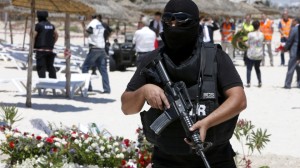How Tunisia can realise its untapped potential

A hooded Tunisian police officer stands guard at the scene of the terror attack on Sousse. (Abdeljalil Bounhar /AP)
Five years ago on January 14, Zine El Abidine Ben Ali, his wife Leila and three children fled Tunis after a month of protests against the autocratic president’s 34-year rule. But he appears to be still alarmingly present in the consciousness of his country, his name coming up in casual conversation around Tunisia in disparate contexts. Mostly, the references are unflattering and those about cultural tourism – or the lack of it in Tunisia – are a good example.
Consider the tittle-tattle from some of Tunisia’s now seriously underemployed tour guides at many of its most glorious sites.
At Kerkouane, on the north-eastern coast, which Unesco declared a World Heritage Site 31 years ago because it is the world’s only surviving example of a Phoenician-Punic city, I am told that excavation stopped because of the greed of the Ben Ali family.
The story goes that Unesco was paying 60 dinars (Dh71) per person per day to work on the site but one of the president’s men was the conduit and only 17 dinars got to each intended recipient.
There was much muttering, says the guide sadly, and faced with the prospect of outright mutiny at the archaeological dig, the UN simply stopped work.
There is talk of reviving the painstaking excavation this year, which would over time finally uncover this remarkable and well-ordered city built 3,000 years ago by migrants from the Levant, complete with clay plumbing, hip baths, house numbers and still-visible mosaic floors. But no one knows when, or even if, this will happen.
At Carthage, the ancient city near the capital Tunis, which saw the rise and fall of two empires – Phoenician and Roman – the word is that Ben Ali’s friends and family used archaeological projects like private ATMs.
Carthage is also a Unesco World Heritage Site and the current government of president Beji Caid Essebsi has promised it will invest in its preservation and presentation. It could use the attention. For now, despite the boast of Tunisia’s ministry of culture that the Carthage museum contains “the largest collection” of objects from the site of Carthage and covers the Phoenician-Punic, the Roman-African and the Arab-Muslim periods, the priceless offerings look like they’re in temporary housing. The displays, without context or chronological order, seem as if they were unfinished attempts at a narrative and that the storyteller gave up halfway through. It is just not good enough to establish Tunisia on the cultural tourism map of the world.
Kerkouane’s unexplored riches and Carthage’s untended wares might almost be a template for the reality of Tunisia’s tourism industry. It is in a painful state of suspended animation, unable to shake off the memory of its glorious past and move past its successes and failures. The endlessly retold stories of the Ben Ali regime’s rapacity may illustrate Tunisia’s debilitating problem with stitching together a compelling new narrative.
Once, mass tourism – sun, sea and all-inclusive packages for European travellers – was a thriving business for Tunisia, contributing 10 per cent to its economy, employing at least 400,000 people and keeping hundreds of hotels up and down its Mediterranean coast in business.
But extremist attacks on tourists at Tunis’s Bardo Museum and a beach in Sousse in March and June respectively resulted in travel warnings from European countries that are major markets.
The assaults killed many people and mortally wounded one major institution – the Tunisian tourism sector’s extended season of hedonistic prosperity. It is not due a revival any time soon. With tour operators pulling out and the cancellation of most charter flights and cruise ships to Tunisian resorts, summer 2016 promises to be a bleak, joyless period of grinding misery for Tunisia’s tourism sector.
But cultural tourism, which would be a more niche and less exposed stream, could go part of the way towards filling the gap. Mass-market travel, by its very nature, creates obvious targets; niche tourism does not. Soon after the Sousse attack, Lyn Hughes, editor-in-chief of Wanderlust magazine, pointed out that it was time Tunisia realised its untapped potential to attract cultural explorers, travellers who go off the beaten track because there is something exceptional to see.
It would be exceedingly lucrative and sustainable, she said, because “the average adventure/cultural/explorer traveller spends more. The money goes further, and benefits extend into communities that are missing out on the mass tourism on the coast. It can create meaningful jobs for the whole year, not just summer, and hence keep communities alive.”
She has a point. Even countries like dirt-poor Haiti, which are a great deal less fortunate than Tunisia in terms of domestic security and stability, have started working the adventure and cultural tourism niche. In late 2014, a Toronto travel company started to sell Haiti “as a place where tourists don’t go, but where real travellers venture”. There are no firm numbers as yet, but Haiti’s cultural tourism sector is considered promising.
Tunisia has so much for the real traveller to see. It has Kairouan, the first mosque built in Africa, within just a few decades of the founding of Islam. Dougga, the 2,000-year-old Roman city, with a magnificent existing theatre, Capitol, temples, shops, houses, public baths and even a bordello. El Jem, a Roman city, with its 35,000-seat existing amphitheatre, second only to the Colosseum in Rome.
All of these could feature on a cultural tourism map that spans 3,000 years of accessible history for the discerning traveller. That it has not happened is assuredly partly because of the Ben Ali regime. But that has been gone for five years. The challenge is for Tunisia’s new leaders to make it happen now.

